When traveling to Sapa, backpackers often cannot miss conquering O Quy Ho Pass to challenge the treacherous mountain passes with sharp turns between deep valleys and towering cliffs on both sides, experiencing the thrill of conquering nature, reaching the summit of the pass, and witnessing the vast and majestic natural scenery with Fansipan peak shrouded in clouds or the sparkling Silver Waterfall. For female travelers, O Quy Ho Pass is attractive with the Heaven’s Gate, a beautiful spot to hunt for clouds and take Instagram-worthy photos. Today, Cuong will provide a detailed review of O Quy Ho Pass – one of the four great passes in the Northwest region!
1. Where is O Quy Ho Pass located?
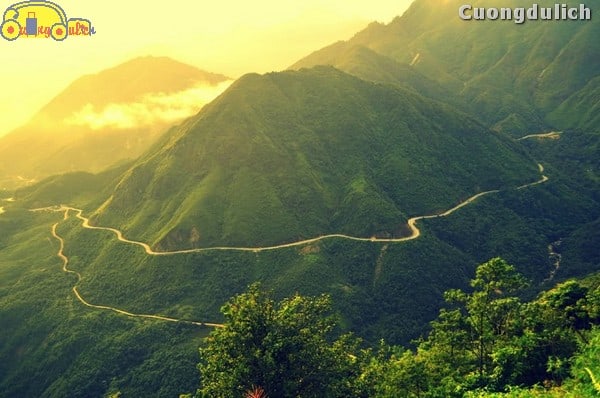
O Quy Ho Pass (Lai Chau) is about 17 km from Sa Pa (Lao Cai). The pass is located on National Highway 4D cutting through the Hoang Lien Son range. O Quy Ho Pass connects the two provinces of Lao Cai and Lai Chau, with the pass’s summit being the border between the two provinces.
O Quy Ho Pass, also known as O Quy Ho or Hoang Lien Son Pass, is one of the longest, most treacherous, and majestic mountain passes in Northern Vietnam. To explain the name O Quy Ho, let’s explore a legend passed down in the region for a long time. It is said that in this mountainous area, there used to be a bird with a haunting cry, associated with a legend of an unfulfilled love story between a young man and woman. The pass is where a fairy and a peasant named O Quy Ho met. Legend has it that due to their inability to be together and longing for each other, the fairy transformed into a golden-feathered bird flying around the mountain peak crying out three times “O Quy Ho” in a poignant manner. Hence, the pass is named O Quy Ho Pass.
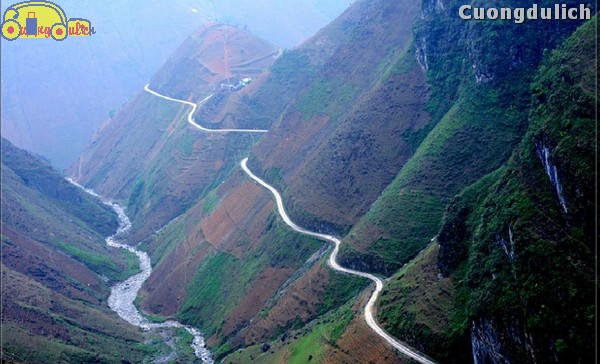
Furthermore, Ô Quy Hồ Pass is also known by the incredibly romantic name of Cloud Pass, as it is located at an altitude of nearly 2,000 meters above sea level, with clouds covering it all year round. That’s why Cuong mentioned Ô Quy Hồ Pass as a very famous cloud hunting spot that appeals to the younger generation. In the evenings, after completing the journey to conquer Ô Quy Hồ Pass and on the way back to Sapa Town, you will see white clouds rolling in to cover the Muong Hoa Valley.
Ô Quy Hồ Pass, along with Mã Pì Lèng Pass, Pha Đin Pass, and Khau Phạ Pass, are the four great passes in the Northwest region. In addition to the aforementioned titles, Ô Quy Hồ Pass is also known as the longest and highest pass in Vietnam, with an altitude of nearly 2,000 meters. The Vietnam Record Organization in 2013 awarded Ô Quy Hồ Pass the title of the longest pass in Vietnam, with a length of nearly 50 km.
2. Directions to Ô Quy Hồ Pass
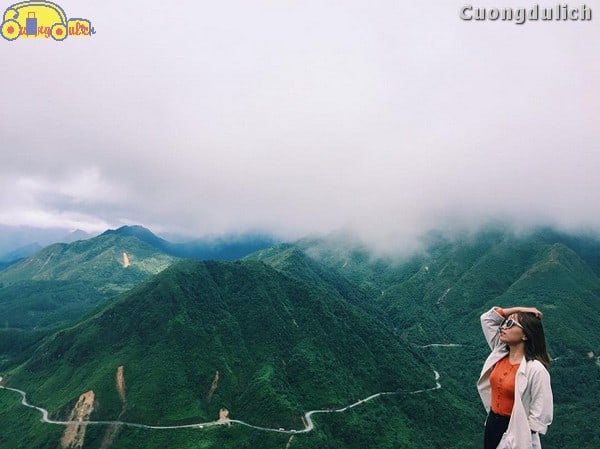
Usually Cuong sees many people going on Sapa tours or taking the opportunity to travel to O Quy Ho pass, so Cuong will introduce the route from Sapa town to O Quy Ho pass for you.
From the center of Sapa town, you will have to travel a long distance of about 12 km through Silver Waterfall, pass through the gate of Hoang Lien Son National Park, then up to the forest ranger station, and just a few more kilometers to reach the peak of O Quy Ho pass. If you start from Sapa town and stop at the pass peak, the distance is approximately 15km. It may sound like a long way, but if you go by car from Sapa, it only takes about 15 minutes. If you take a taxi, the cost for this route is around 200k.
The ideal journey is to start from the town (bus station), drive along Dien Bien Phu street, 12km to Silver Waterfall, then continue straight to the peak of the pass. Along the way, you will pass through many beautiful tourist spots in Sapa such as Silver Waterfall, Love Waterfall… If you have time, take a break to rest before continuing to conquer the pass road and take advantage of the opportunity to take some virtual photos next to the sparkling white foam waterfalls, cool and refreshing in Sapa. Also, on the way from Sapa town to the sky gate, you will pass by some virtual spots, beautiful places like H’mong Flower Garden, Homestay Cối Xay… Don’t forget to visit and explore those interesting check-in spots.
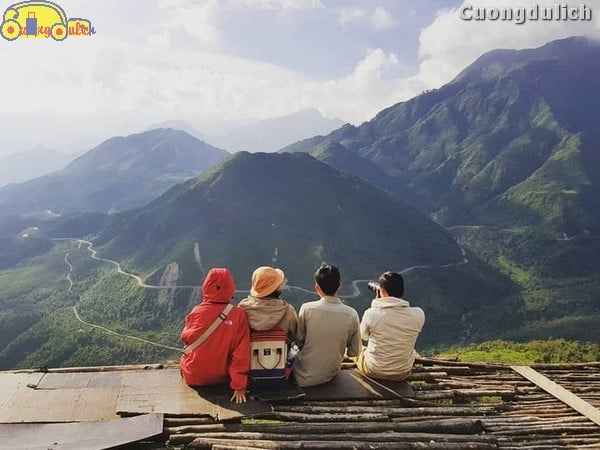
The second way to reach the summit of O Quy Ho Pass is from the city of Lao Cai: From Lao Cai, you can take a bus, a coach, or rent a motorbike to Sapa town, then travel similarly to the route above. The road from Lao Cai city to Sapa town is only about 30km, but it is a mountainous road with many dangerous curves. So if you intend to travel this section by motorbike, you must be very careful and have a strong grip on the handlebars! For the ladies with boyfriends, you should let your partner do the driving, as the mountain road has many curves and steep sections, causing girls to often have shaky hands.
3. How to get to O Quy Ho Pass?
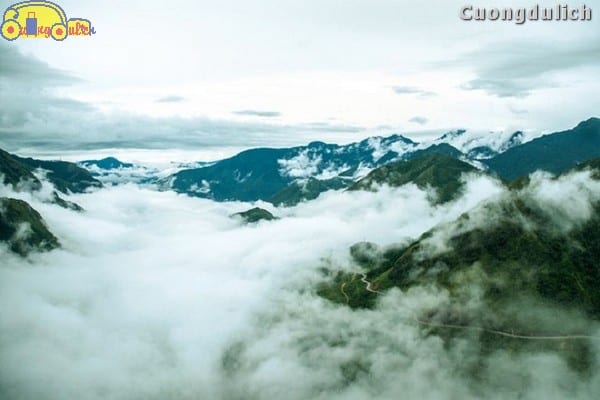
Currently, there are many ways for you to conquer one of the four great passes in the Northwest such as renting a passenger car, taking a bus, or a taxi. However, for those who love adventure, you must conquer O Quy Ho Pass by motorbike, right? Despite that, with one side being a deep abyss and the other side a steep mountain wall, O Quy Ho Pass is still a challenge for drivers, with danger warning signs erected on both sides of the road.
However, don’t worry about whether it is dangerous to go through O Quy Ho Pass because nowadays this route has been upgraded, helping to reduce accidents and becoming a “must conquer once” route for adventurers. Especially on rainy or frosty days, visibility ahead is only a few meters. Cars can only “crawl” slowly, clinging to the mountain wall to pass the pass. Or daring to cross the pass at night, can make people feel “goosebumps” due to the eerie feeling in the dark mist, accompanied by the sound of wind whistling through the mountain crevices. Not to mention, when winter comes, many areas around the peak of O Quy Ho Pass may be covered with thick snow, very slippery and difficult to travel…
However, the harder something is to conquer, the more valuable it is, right? Overcoming all the dangerous stretches to reach the peak of the pass and then bursting out in front of the magnificent natural scenery, you will feel that the efforts you have put in are not in vain at all, the difficulties you have gone through are truly worth it. Consider O Quy Ho Pass as a challenge to overcome to discover the hidden potential within yourself!
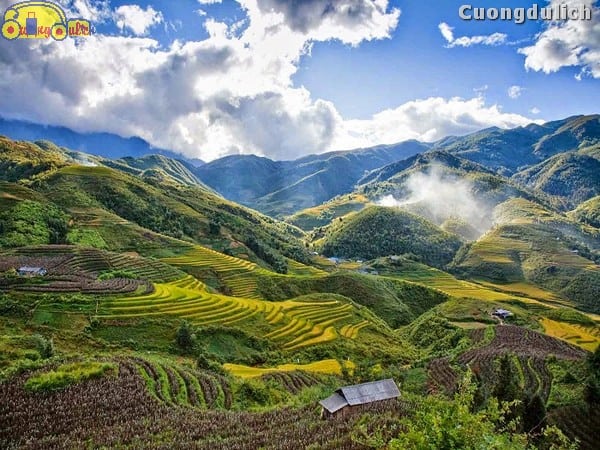
The O Quy Ho Pass route is very dangerous, especially the section from Ton station down the pass, which includes many steep cliffs making it very difficult to traverse. Therefore, according to Cuong, you should start your journey around noon to have a clearer view of the road, making it easier to move. The journey of exploration may be challenging, but you will surely not regret setting foot here.
Furthermore, there is now a safer and more convenient way to quickly conquer the O Quy Ho Pass summit, which is by taking the cable car. You can easily purchase cable car tickets at the station (buy tickets to visit Fansipan peak). From Fansipan peak, you move to Thac Bac area, then to Ton station, and then travel about 4-5 km along QL 4D to reach the O Quy Ho Pass summit.
4. When is the best time to travel to O Quy Ho Pass?
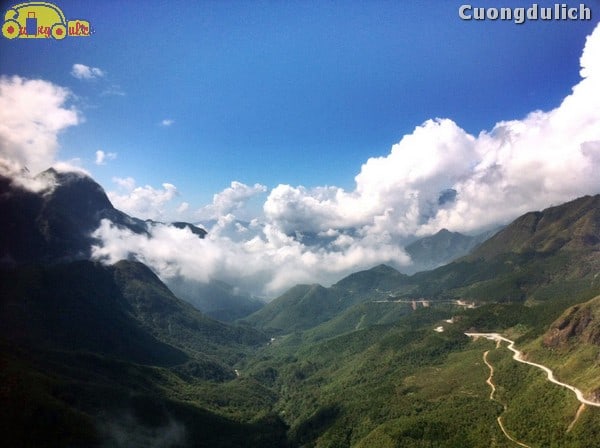
The answer is that you can go cloud hunting on the peak of O Quy Ho Pass in any season of the year. In winter, there is snow, and O Quy Ho Pass presents a melancholic beauty, with the land shining brightly in the white snow. In summer, O Quy Ho Pass is often covered in floating clouds, creating an attractive sight for both domestic and international tourists, making it an ideal cloud hunting spot for young people who love virtual living. Or when traveling to Sapa in autumn and passing through O Quy Ho Pass, you will see the lush green terraced fields now turning into the golden color of ripe rice, with the whole valley draped in a vibrant yellow like a sea of gold. When spring arrives, the vast green forests on the mountains are adorned with the bright pink of cherry blossoms, the pure white of apricot blossoms, plum blossoms, and pear blossoms. Indeed, going through O Quy Ho Pass in any season is beautiful, isn’t it? In any season, you will have stunning check-in photos.
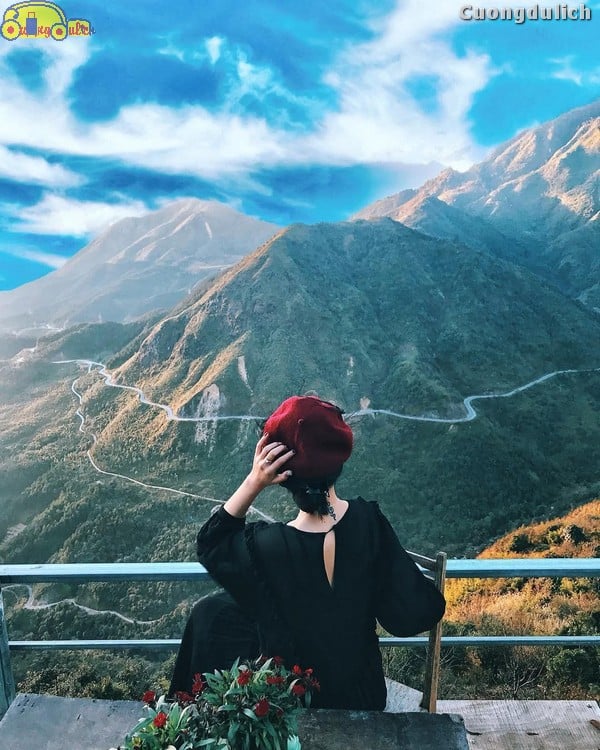
Although both are mountain passes, the weather on O Quy Ho Pass is very different on the side of Lao Cai and the side of Lai Chau. On the Lao Cai side, it’s foggy, while on the Lai Chau side, it’s warm and sunny, so you can capture the pass in the mist or under the bright sunlight.
Ms. Minh Trang, a traveler from Hanoi, shared with Cuong: “I have crossed O Quy Ho Pass twice by motorbike, once during the day and once at night under the full moon. Each time was a very different experience and brought different feelings. On full moon nights, with clear skies, the light shining on the standing cliffs or passing through the leaves on the road is very beautiful and mystical. Stopping the bike at the top of the pass, being silent for a moment to listen to the sounds of the forest, the insects, the wind passing through the cliffs… only then can you feel the peace and the passion for exploration of travelers.”
Read more:
Extremely Detailed Review of 20 Sapa Travel Destinations for First-Time Sapa Visitors
Top Most Outstanding Tourist Attractions in Sapa
5. Scenic Stops for Photoshoots and Instagram-Worthy Shots on O Quy Ho Pass
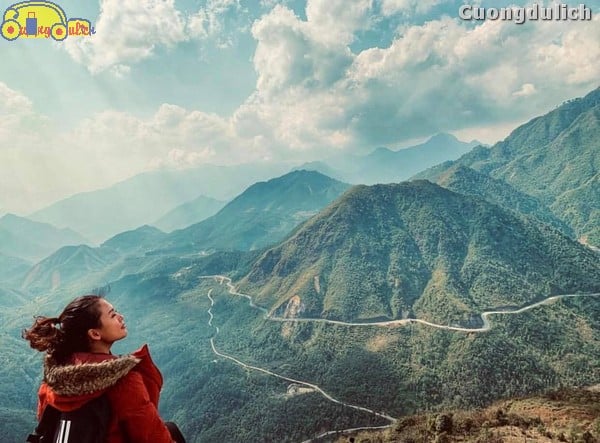
If you wonder why in the directions, Cuong always guides you to the top of O Quy Ho pass, now Cuong will explain it. The reason is very simple, because the peak of O Quy Ho pass offers the highest and most beautiful view, overlooking the Sapa valley and is also an ideal spot for cloud hunting and taking Instagram-worthy photos.
From the pass on a clear day, you will have the opportunity to admire the panoramic view of the winding road crossing through majestic mountains to Binh Lu or back to Sapa. On a sunny day, you can even see the majestic view of Fansipan mountain – the rooftop of Indochina from the direction of Lai Chau.
During the cold winter, with some days below 0°C, the scenery of O Quy Ho pass is uniquely beautiful, rarely found elsewhere due to the white snow covering the forest. For those living in the plains, who rarely see snow, the sight of everything covered in white, trees, leaves, grass, all blanketed in snow is a pure and unforgettable scene! That’s why many people travel to Sapa and visit O Quy Ho pass in winter to see the snow. Despite the freezing cold, people shiver in their warm coats, the feeling of being lost in a snowy landscape feels like being abroad, especially in the European-style architecture of Sapa, like the ancient stone church, it’s like stepping into a white snow castle in a fairy tale!
5.1 O Quy Ho Heaven’s Gate
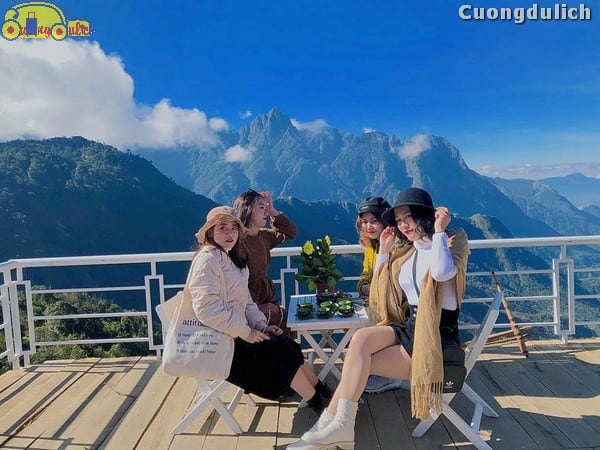
The reason why O Quy Ho Pass is often likened to the Gate of Heaven is because of its beautiful scenery, which is as magnificent as a gate leading up to the sky. The Gate of Heaven at O Quy Ho Pass is the peak of the pass with a resting point featuring a wooden railing on the edge of the cliff, adorned with hanging wild orchids. Standing here, you can overlook a vast area, a spectacular landscape with white fluffy clouds floating over the rugged mountain ranges, covering the lush primeval forests; below are the green valleys, glimpses of rustic villages; and the O Quy Ho Pass appears as gentle as a white silk ribbon winding through the majestic mountains… Furthermore, if you stay until the evening, you can admire the sunset coloring the space with enchanting hues.
Oh, Cuong would like to note that many people often mistake the Gate of Heaven on Ham Rong Mountain for the Gate of Heaven at O Quy Ho Pass when visiting Sapa. In fact, there are two Gates of Heaven in Sapa, one on Ham Rong Mountain near Sapa Town, and the other is the Gate of Heaven at O Quy Ho Pass that we are talking about.
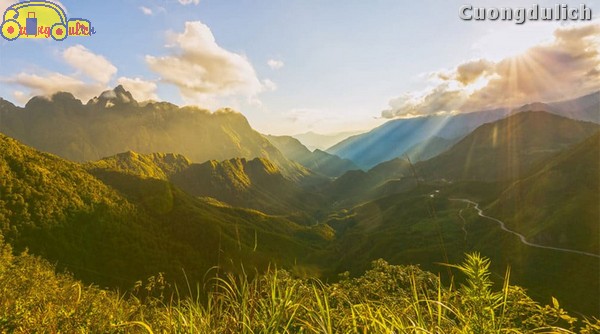
At the foot of the pass towards Sa Pa is Thac Bac, one of the 10 most beautiful waterfalls in Lao Cai, always attracting young people to explore. The beauty of the O Quy Ho pass has long attracted a large number of international tourists to admire, and this place is also a source of creative inspiration for many famous Vietnamese artists such as Nguyen Tuan, Xuan Dieu, Xuan Quynh, Nguyen Thanh Long, Vo An Ninh, Vinh Cat, Ma Van Khang, and Lo Ngan Sun.
Previously, there were many cafes and eateries along the O Quy Ho pass, serving as a place for visitors to rest, enjoy a cup of coffee while admiring the scenery and taking photos. This is also an ideal spot for cloud hunting for young people, enjoying coffee while watching the white fluffy clouds drift by.
However, since July 31st, this complex of cafes and eateries has been demolished. About 2 – 3 years ago, there were only about 3 – 4 wooden huts on the pass, looking very Northwestern. However, in the past 2 years, the number of tourists visiting Sapa has increased, leading to a rush to build new steel and wooden structures, constructing a series of new huts. Roughly counting, there are nearly 30 huts on the pass with various styles, both beautiful and ugly. This has raised many issues that the authorities cannot ignore, especially in terms of traffic safety and the safety of tourists admiring the scenery, as these establishments are built precariously on the slope of the pass. Although the news of the demolition of the cafe complex on O Quy Ho pass has caused much regret among young people, as they have lost a spot for cloud hunting on the pass, safety should always come first, shouldn’t it?
5.2 O Quy Ho Glass Bridge
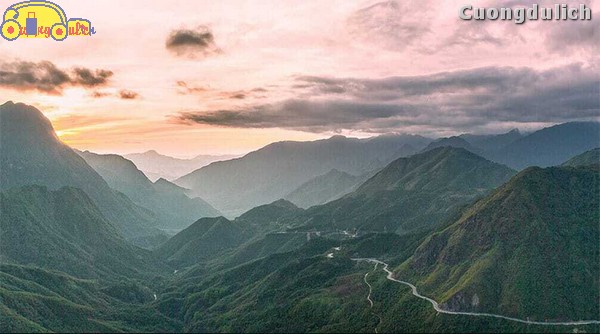
According to Cuong, a very large glass bridge is being built in the O Quy Ho Pass area. This glass bridge is part of the Rong May eco-tourism resort, located at an altitude of over 1,000 meters near the peak of O Quy Ho Pass. It is expected that when completed, the O Quy Ho glass bridge will become one of the tallest and longest glass bridges in Southeast Asia, with a capacity of over 3,000 people at a time. The glass bridge is expected to extend out over the mountain cliff with a length of 60m and a height of 500m, entirely made of transparent glass. In addition, visitors will also have the opportunity to explore and experience the outdoor sky ladder system at a height of 300m. Within the Rong May tourist area, there are many other activities available such as bungee jumping, ziplining, paragliding…
6. What to eat when going up O Quy Ho Pass?
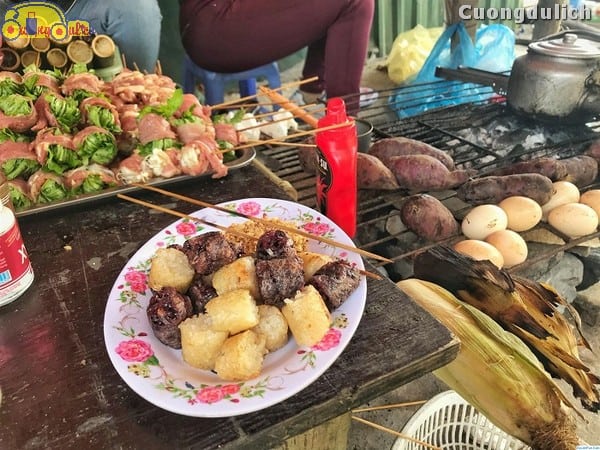
One essential part when you travel to Sa Pa in general or conquer the O Quy Ho Pass in particular is not to forget to explore the unique cuisine here. Not only famous for its breathtaking beauty, but the local dishes here also captivate the hearts of diners from all directions.
On this adventurous journey along the pass, travelers can stop at various eateries to enjoy many rustic dishes that are specialties of the Northwest region such as: buffalo meat cooked on a stove (a bit expensive but extremely delicious), armpit pork, hill chicken, grilled corn, grilled sweet potatoes, etc. Pork armpit and hill chicken are the signature dishes of Sapa. As for grilled sweet potatoes, Cuong must tell you that during the exploration of Vietnam, the World Theme Travel program of EBS Korea also visited the mountainous region of the Northwest, specifically Lao Cai and Lai Chau. The EBS Korea reporter went to O Quy Ho Pass to eat cheap grilled sweet potatoes. Holding the hot grilled sweet potato, the reporter seemed unable to wait to taste the sweet and starchy flavor of the grilled sweet potato. Peeling off the crispy skin because it was grilled on charcoal, the golden sweet potato emerged, the Korean reporter found it so delicious that he carefully peeled the skin to not miss any bit.
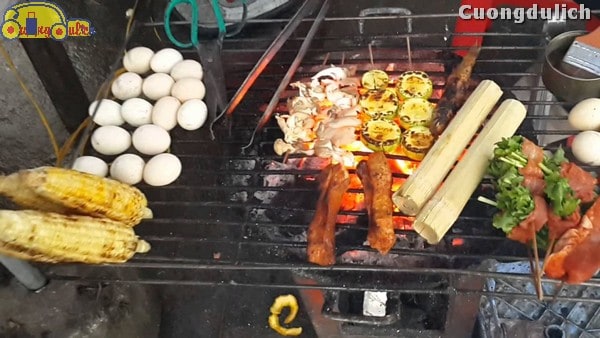
Furthermore, in Sa Pa, there are also some special vegetable species such as chayote, cat’s ear cabbage,… When you pass through O Quy Ho pass, you can see many ethnic minority families growing chayote in the valley, the lush green chayote vines covering the whole area. These vegetables are grown and cared for by the ethnic people without any pesticides, so they are very fresh, delicious, and clean.
Especially, the dish you must try is the bamboo-tube rice served with grilled skewered meat, and you can also enjoy it with grilled chicken eggs.
While savoring the food and admiring the beauty of this place, you can see the majestic Fansipan mountain, the poetic Silver Waterfall, the beautiful terraced fields… The feeling of breathing in the fresh air of the high pass and then sitting by the warm fire, enjoying a cup of hot tea or eating sweet potatoes, and hot corn is just perfect!
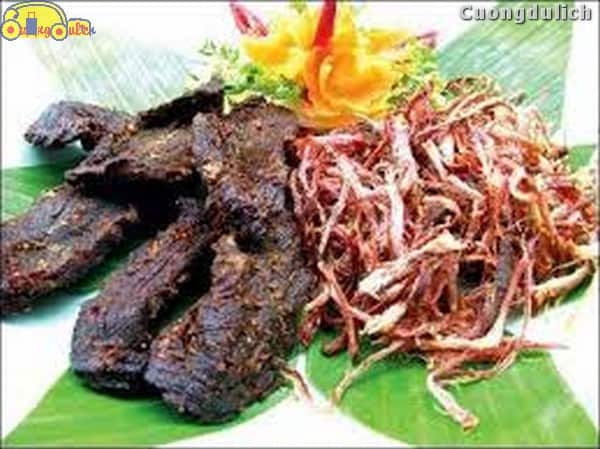
Next to that, the stalls of the local people along the O Quy Ho pass also sell many local products such as: scarves, dresses, bracelets, anklets, silver jewelry, agricultural tools, agricultural products (mushrooms, medicinal leaves, etc.) for tourists to buy as gifts.
One day, Cuong and his family went to admire the scenery of O Quy Ho pass in drizzling rain, and it was very cold. The white clouds covered all four sides, the visibility was less than 1km, let alone admiring O Quy Ho pass. At the top of the pass, there are a few small houses selling clothes, dried products, and grilled food. The feeling of the whole family gathering around a warm small grill, drinking sweet grass tea, chatting, eating grilled corn, skewered meat, or buffalo meat cooked on the grill… was truly wonderful. Cuong’s older brother said he had been here 4 or 5 times, and only once was the weather nice, with few clouds, and he could admire O Quy Ho pass from afar. The rest of the times, they mostly came to enjoy the feeling of being next to a warm fire in that cold weather. On the way, Cuong also met a group of cyclists going up, who seemed very happy. Perhaps next time when visiting Sapa, it would be worth trying to rent a bike!
7. Things to keep in mind when traveling to O Quy Ho pass
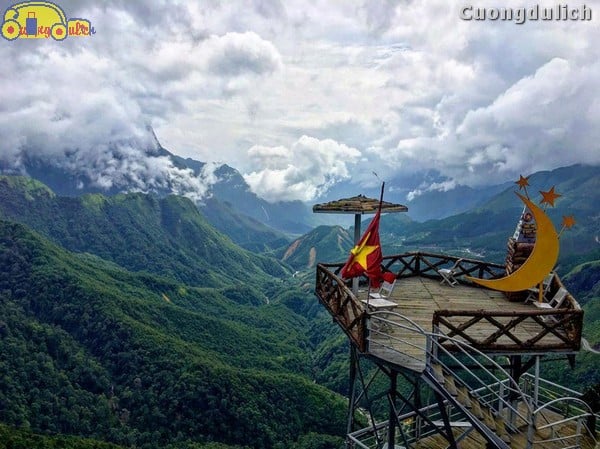
1. Due to the location of the O Quy Ho Pass gateway on the National Highway, various vehicles continue to pass through, especially containers, buses, motorcycles… In addition, the terrain of the pass is one side deep abyss, the other side is steep cliffs, so you need to be very careful when parking and taking photos here. You should park neatly, observe carefully, and not play around or run to the edge of the road as it can be very dangerous.
2. You should drive slowly, stay away from the right side of the road as tourist cars or buses sometimes take sharp turns.
3. As the pass is at an altitude of over 2,000 meters above sea level, the weather is very cold and windy, so you should prepare warm clothes, gloves, hats, and scarves.
8. Some tourist attractions near O Quy Ho Pass in Sapa
Near O Quy Ho Pass, you can visit other famous tourist attractions in Sapa such as Silver Waterfall, Love Waterfall, Tram Ton… Cuong will suggest you an itinerary to conquer the entire O Quy Ho Pass in one day: First, visit the summit of Fansipan, then move on to visit attractions like Silver Waterfall – Love Waterfall – Golden Stream, and finally head to the O Quy Ho Pass gateway. If you have spare time after visiting all these places, take a detour to the Sapa Flower Garden for more picturesque photo opportunities.
8.1 Fansipan Summit
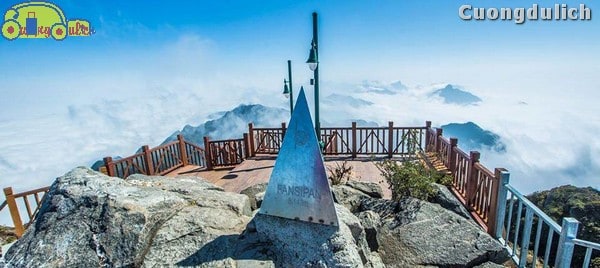
Fansipan is the highest mountain in Vietnam, and also the highest in the Indochina region, hence it is known as the “Roof of Indochina”. Fansipan mountain is 3,143 meters above sea level, located in the center of the Hoang Lien Son range, on the border between Lai Chau and Lao Cai provinces, 9 km southwest of Sapa town.
8.2 Silver Waterfall Sapa

Located 15 km from the town of Sapa towards Lai Chau, Thac Bac is over 200 meters high, with a stream of white water pouring down below. From a distance, the waterfall looks like a silver strip hanging in the air, hence its romantic name, Thac Bac.
8.3 Love Waterfall Sapa
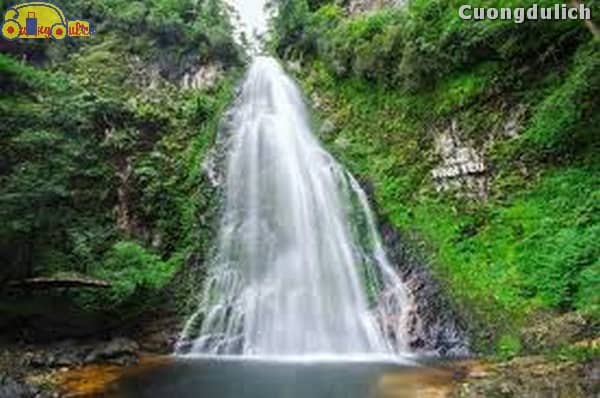
About 4 km from the center of Sapa town in the southwest direction, there is a waterfall located on the Vang stream, originating from the peak of Fansipan, flowing through steep terrain down below, with lush green vegetation on both sides of the waterfall.
So Cuong has provided you with a very detailed review of O Quy Ho Pass, one of the 4 major passes in the Northwest region. When you travel to Sapa, especially on 2-day 1-night Sapa tours or 3-day 2-night Sapa tours, remember to spend some time hunting for clouds at O Quy Ho Pass. Currently, Cuong knows that many travel companies offer all-inclusive Sapa tours that include destinations such as Fansipan peak, Ham Rong Mountain, Silver Waterfall, Love Waterfall, and O Quy Ho Pass, making it very convenient for you to explore all the scenic spots in Sapa. Wishing you a steady hand on the wheel (if traveling by motorbike or car) and beautiful check-in photos at O Quy Ho Pass!
.
